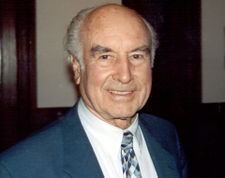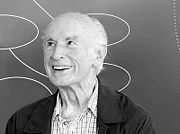Albert Hofmann
| Albert Hofmann | |
|---|---|
 Albert Hofmann in 1993
|
|
| Born | January 11, 1906 Baden, Switzerland |
| Died | April 29, 2008 (aged 102) Burg im Leimental, Switzerland |
| Residence | Switzerland |
| Nationality | Swiss |
| Fields | Chemist |
| Alma mater | University of Zürich |
| Known for | Synthesis of LSD-25 |
Albert Hofmann (January 11, 1906 – April 29, 2008[1][2]) was a Swiss scientist known best for being the first person to synthesize, ingest and learn of the psychedelic effects of lysergic acid diethylamide (LSD). He authored more than 100 scientific articles and a number of books, including LSD: My Problem Child.[2]
Contents |
Life and career
Hofmann was born in Baden, Switzerland, the first of four children born to factory toolmaker Adolf Hofmann and his wife Elisabeth (born Elisabeth Schenk). Because of his father's low income, Albert's godfather paid for his education. When his father became ill, Hofmann obtained a position as a commercial apprentice in concurrence with his studies. At the age of twenty, Hofmann began his chemistry degree at the University of Zürich, finishing three years later, during 1929. His main interest was the chemistry of plants and animals, and he later conducted important research regarding the chemical structure of the common animal substance chitin, for which he received his doctorate, with distinction, during 1930.
Discovery of LSD
Hofmann became an employee of the pharmaceutical-chemical department of Sandoz Laboratories (now Novartis), located in Basel as a co-worker with professor Arthur Stoll, founder and director of the pharmaceutical department.[3] He began studying the medicinal plant squill and the fungus ergot as part of a program to purify and synthesize active constituents for use as pharmaceuticals. His main contribution was to elucidate the chemical structure of the common nucleus of Scilla glycosides (an active principal of Mediterranean Squill).[3] While researching lysergic acid derivatives, Hofmann first synthesized LSD on November 16, 1938.[4] The main intention of the synthesis was to obtain a respiratory and circulatory stimulant (an analeptic). It was set aside for five years, until April 19, 1943, when Hofmann decided to reexamine it. While re-synthesizing LSD, he accidentally absorbed a small quantity through his fingertips[5] and serendipitously discovered its powerful effects. He described what he felt as being:
... affected by a remarkable restlessness, combined with a slight dizziness. At home I lay down and sank into a not unpleasant intoxicated-like condition, characterized by an extremely stimulated imagination. In a dreamlike state, with eyes closed (I found the daylight to be unpleasantly glaring), I perceived an uninterrupted stream of fantastic pictures, extraordinary shapes with intense, kaleidoscopic play of colors. After some two hours this condition faded away.[6]
Further research
| “ | I think that in human evolution it has never been as necessary to have this substance LSD. It is just a tool to turn us into what we are supposed to be. | ” |
|
—Albert Hofmann, [7] |
||
Hofmann became director of the natural products department at Sandoz and continued studying hallucinogenic substances found in Mexican mushrooms and other plants used by the aboriginal people. This led to the synthesis of psilocybin, the active agent of many "magic mushrooms."[8] Hofmann also became interested in the seeds of the Mexican morning glory species Rivea corymbosa, the seeds of which are called Ololiuhqui by the natives. He was surprised to find the active compound of Ololiuhqui, ergine (lysergic acid amide), to be closely related to LSD.
During 1962, he and his wife Anita traveled to southern Mexico to search for the plant "Ska Maria Pastora" (Leaves of Mary the Shepherdess), later known as Salvia divinorum. He was able to obtain samples of this plant but never succeeded in identifying its active compound which has since been identified as the diterpenoid Salvinorin A.

During 1963, Hofmann attended the annual convention of the World Academy of Arts and Sciences (WAAS) in Stockholm.
Hofmann called LSD "medicine for the soul" and was frustrated by the worldwide prohibition of it. "It was used very successfully for 10 years in psychoanalysis," he said, adding that the drug was misused by the Counterculture of the 1960s and then criticized unfairly by the establishment. He conceded that LSD can be dangerous if used by the wrong people.[9]
During December 2007, Swiss medical authorities permitted a psychotherapist to perform psychotherapeutic experiments with patients who suffer from terminal stage cancer and other deadly diseases. Although not yet started, these experiments will represent the first study of the therapeutic effects of LSD for humans in 35 years, as other studies have focused on the drug's effects on consciousness and body. Hofmann acclaimed the study, and continued to say he believed in the therapeutic benefits of LSD.[10]
Hofmann was due to speak at the World Psychedelic Forum[11] from March 21 to March 24, 2008, but was forced to cancel because of bad health.
Death
Hofmann died of natural causes on April 29, 2008, in the village of Burg im Leimental, near Basel, Switzerland. He was 102 years old.[12][13][14]
Books
Albert Hofmann's autobiographical account of his experience with LSD was published in LSD: My Problem Child (1980). Hofmann also co-authored The Road to Eleusis: Unveiling the Secret of the Mysteries (Hermes Press, 1998, North Atlantic Books, 2008), a collaborative effort with mycologist R. Gordon Wasson, and classical scholars Carl Ruck and Blaise Staples, which reveals the secret mystic elixir that is at the heart of the Eleusinian Mysteries and, therefore, arguably fundamental to the development of Western civilization. Hofmann further describes the relevance of the Eleusinian Mysteries for today's world, and the application of psychedelic experience to the study of metaphysics, in essays published in Entheogens and the Future of Religion, (Council on Spiritual Practices, San Francisco, 1999); and discusses his relationship with LSD enthusiast Timothy Leary in Outside Looking In (Park Street Press, Rochester, VT, 1999). Also, a posthumous book by Albert Hoffman, Hofmann's Elixir: LSD and the New Eleusis, collecting the last essays the author wrote, was released Feb. 24th, 2010.[15]
Further reading
- Nathaniel S. Finney, Jay S. Siegel: In Memoriam – Albert Hofmann (1906–2008). Chimia 62 (2008), 444–447, doi:10.2533/chimia.2008.444
- Roberts, Andy. Albion Dreaming: A Popular History of LSD in Britain (2008), Marshall Cavendish, U.K, 978-1905736270/1905736274
References
- ↑ "Albert Hofmann". Multidisciplinary Association for Psychedelic Studies. http://www.maps.org/. Retrieved 2008-04-29.
- ↑ 2.0 2.1 "Obituary: Albert Hofmann, LSD inventor". Daily Telegraph. http://www.telegraph.co.uk/news/obituaries/1912485/Albert-Hofmann,-LSD-inventor,-dies.html. Retrieved 2008-04-29.
- ↑ 3.0 3.1 "Freedom of speech - use it or lose it". Flashback.se. http://www.flashback.se/archive/my_problem_child/chapter1.html. Retrieved 2009-11-16.
- ↑ Dr. Albert Hofmann; translated from the original German (LSD Ganz Persönlich) by J. Ott. MAPS-Volume 6 Number 69 Summer 1969
- ↑ "Europe | LSD inventor Albert Hofmann dies". BBC News. 2008-04-30. http://news.bbc.co.uk/2/hi/europe/7374846.stm. Retrieved 2010-03-02.
- ↑ Hofmann 1980, p. 15
- ↑ "LSD: The Geek's Wonder Drug?". Wired.com. 2006-01-16. http://www.wired.com/science/discoveries/news/2006/01/70015?currentPage=2. Retrieved 2008-04-29.
- ↑ Bleidt, Barry; Michael Montagne (1996). Clinical Research in Pharmaceutical Development. Informa Health Care. pp. 36, 42–43. ISBN 0824797450.
- ↑ "New York Times article". http://www.nytimes.com/2006/01/07/international/europe/07hoffman.html.
- ↑ "The comeback of LSD - swissinfo.ch". http://www.swissinfo.ch/ger/wissen_und_technik/detail/Das_Comeback_von_LSD.html?siteSect=511&sid=8883306&cKey=1206100275000&ty=st.
- ↑ "World Psychedelic Forum". http://www.psychedelic.info/content_eng/wpf_eng_speakers.html.
- ↑ "Albert Hofmann, the Father of LSD, Dies at 102". http://www.nytimes.com/2008/04/30/world/europe/30hofmann.html. Retrieved 2008-04-30.
- ↑ "LSD inventor Albert Hofmann dies aged 102". http://www.straight.com/article-143764/lsd-inventor-albert-hofmann-dies-aged-102. Retrieved 2008-04-30.
- ↑ "Albert Hofmann, Obituary, Economist.com". http://www.economist.com/obituary/displaystory.cfm?story_id=11328656. Retrieved 2008-05-08.
- ↑ "Amazon.com: Hofmann's Elixir: LSD and the New Eleusis". http://www.amazon.com/Hofmanns-Elixir-LSD-New-Eleusis/dp/0954805496. Retrieved 2009-08-14.
External links
- Albert Hofmann Foundation
- LSD: My Problem Child Career Autobiography
- INSIGHT OUTLOOK A book by Albert Hofmann
- Albert Hofmann (NNDB)
- Erowid: Albert Hofmann Vault
- MAPS ("Stanislav Grof interviews Dr. Albert Hofmann")
- Albert Hofmann – Daily Telegraph obituary
- Watch Hofmann's Potion, a documentary on the origins of LSD
- LSD Returns--For Psychotherapeutics (Scientific American Magazine article)